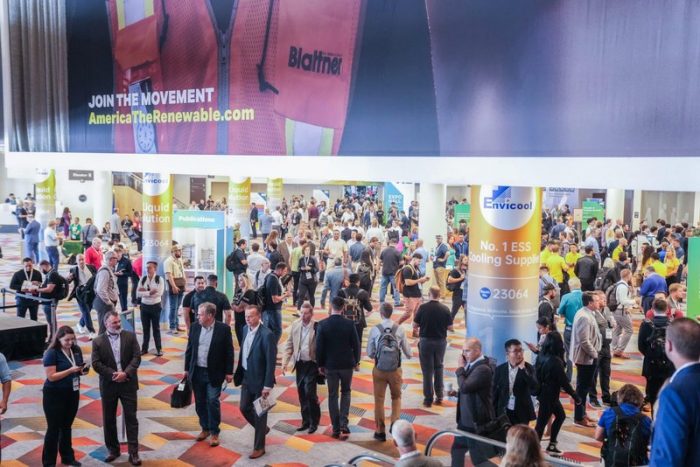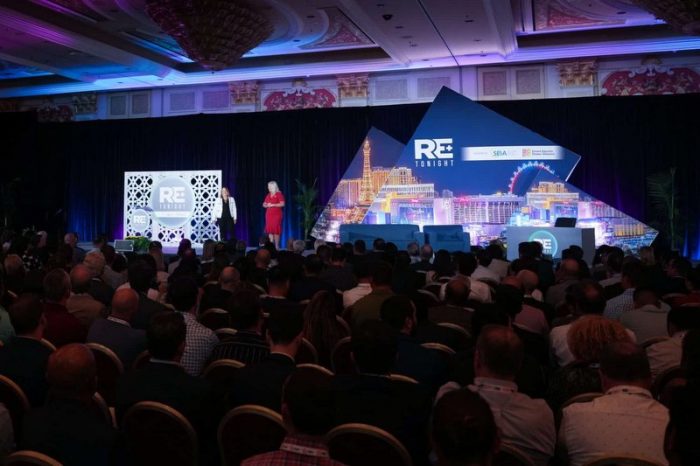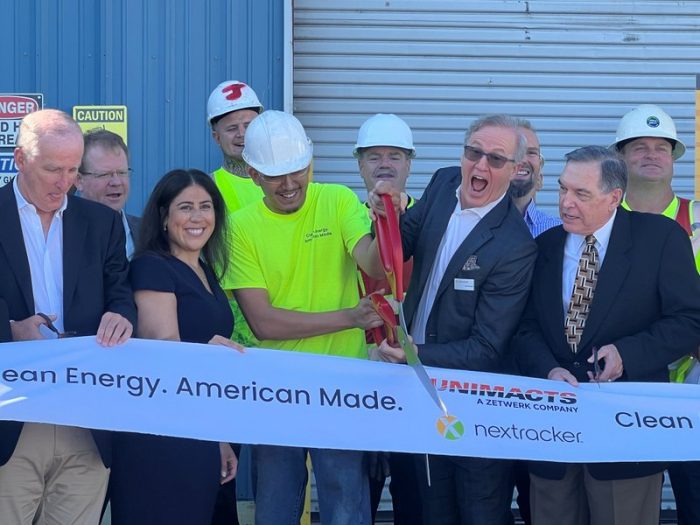
A horde of 40,000 solar + storage industry enthusiasts overran the Venetian Casino in Las Vegas last week at the 2023 RE+ renewable energy show — a horde that included Olympic gold medalist Michael Phelps. The show was so big this year, organizers were forced to add a second casino to provide enough space for attendees and the 1,350 exhibitors at this year’s record-breaking event. Last year a mere 27,000 attendees were counted.
Superlatives were in no short supply among officials describing this auspicious point in time for the solar + storage industry. “New Era,” “Green Revolution,” “Unprecedented,” and other phrases flowed freely in speeches, on billboards and among attendees.
“All of you are visionaries who have made our clean energy future our reality today,” said Abigail Ross Hopper, the CEO of the Solar Energy Industries Association in her opening address to an over-packed ballroom on Monday.

The bottom line, for her, for SEIA, and for the industry at large, is booming. “The Inflation Reduction Act…has had nothing short of an extraordinary impact on the way we do business and the rate at which we can realize progress. As a result of the Inflation Reduction Act, the U.S. solar and storage industry will add $565 billion to our economy over the next decade, creating another half a million jobs along the way,” Hopper reckoned.
Key to this economic phenomenon is the new wave of on-shore production capacity in the renewable energy industry. “Since the IRA passed, we’ve seen more than 59 solar manufacturing announcements. If all of these facilities come online by 2026, they would have the potential to meet 250% [about 200 GW] of our nation’s current demand for solar,” Hopper calculated.
Tracking Made In America

The rush to secure product along the supply chain to meet the IRA’s full tax credit benefit requirements has put new pressure on the supply chain. Solar + storage manufacturers are making sea-changes in their supply chain strategies at an unprecedented pace.
One example of this scramble was unveiled during the show by Nextracker, which formally opened a new dedicated Las Vegas factory for the steel tubes used in the company’s single-axis trackers. The facility is owned and operated by Unimacts, and will primarily serve projects in Nevada and southwestern states, Nextracker said.
“By partnering with Unimacts on this new production line, we’re bringing back American manufacturing jobs and building out America’s energy infrastructure to enhance energy security and de-risk the supply chain,” said Dan Shugar, founder and CEO of Nextracker. “This plant will support our customers with quick shipping and American-made products,” he said.
The investment in the new facility is just one point of light in the company’s sourcing tapestry. “This is Nextracker’s sixth public dedication of a new manufacturing facility since 2022 and the 15th facility the company opened or expanded with key suppliers in the U.S. in that time,” a company statement noted.
Another notable announcement made at the show: OMCO Solar, a solar tracker and fixed-tilt solutions manufacturer that owns its own facilities, all in the U.S., will be opening its sixth U.S. manufacturing facility. The new facility, its second in Alabama, will feature four new manufacturing systems for OMCO Solar’s Fixed Tilt Choice and Origin Tracker solutions.
Perhaps more notably: The site will also manufacture module backrails for First Solar’s Series 7 modules.
“The First Solar agreement, and our newest facility in Alabama, demonstrate our commitment to bolster domestic manufacturing, create U.S. jobs, and provide factory-direct solutions that solve for the complexity of utility-scale solar projects,” stated Gary Schuster, CEO of OMCO Solar.
This significant expansion will bolster OMCO Solar’s overall manufacturing capacity to over 10 GW across its six facilities, encompassing more than 700,000 square feet of manufacturing space throughout the U.S.
“Ever since we made the strategic decision to build a domestic value chain in 2019, we have built a supply ecosystem that demonstrates that it is possible to manufacture a solar module in America, for America, with domestically sourced materials including glass and steel,” said Mike Koralewski, chief supply chain officer, First Solar.
“As the nation’s only solar mounting company that produces all our own structural components in our factories, we offer First Solar and our developer partners certainty in product supply with our model of OMCO Solar is ‘Made in America’. Our supply chain is reliable and flexible to adjust to ever changing project schedules,” concluded Eric Goodwin, Director of Business Development for OMCO Solar.
On the module side, Trina Solar announced it will build a more than 1 million sq ft solar PV manufacturing facility in Wilmer, Texas. The company is investing more than $200 million in property and equipment. Starting in 2024, the facility will produce innovative large power output Vertex modules using the state-of-the-art 210mm large size wafer and the most advanced technology in the solar industry.
“We have long had a vision to manufacture solar products in the United States, and we are proud of the jobs we are creating and the investment we are making in the Wilmer community,” said Steven Zhu, president of Trina Solar US. “Trina’s goal in building this facility is to begin to create an ecosystem of American manufacturing that can serve the burgeoning U.S. solar market.”
We’ll have more from our chat with Trina in the coming days.
The U.S. Treasury department has not yet specified how companies can certify the origins of their components, although customers are already demanding such certification for future order fulfillment.
Help is on the way. SEIA soon will be providing the solar and storage industry with a “first-of-its-kind standardized tool for tracing supply chain origination,” Hopper promised.
Corporate adoption strategies evolve
The underlying theme running through the show was how to tap into IRA benefits — among other benefits from all levels of government — to plan for investments in new renewable energy generation/storage plants.
As the end-users who help drive the booming U.S. solar + storage market, corporations are developing more varied approaches to adopting new capacity.
One session that focused on this evolution was moderated by SEIA’s Senior Director of Research, Shawn Rumery. The session, “Clean Energy’s Role in Achieving Ambitious Corporate Sustainability Goals,” sought to highlight the ways that “some companies look to meet their goals by building onsite or offsite solar systems, others by using PPAs or virtual PPAs, some that make tax credit investments through the ITC, and some purchase SRECs. There is no standard way of setting, achieving, and tracking sustainability goals and, often, progress is hard to measure,” the session poster noted.
One rising corporate concept in adoption strategy is additionality — when organizations directly add new capacity for renewable energy to the national grid by committing to and investing in green power generators in a way that allows them to fund new renewable power generation while moving toward net zero goals.
“Additionality is where the whole industry is going,” suggested panel member Yuri Horwitz, the CEO of Sol Systems.
The federal government is helping to inspire the additionality quest. “Under the SEC’s proposed climate disclosure rule, companies must provide an accounting of their greenhouse gas (GHG) emissions, the environmental risks they face, and the measures they’re taking in response,” Deloitte explains.
More equitable growth a firm mandate
Another focal element of changing corporate adoption plans is the consideration of community benefit, noted Jennifer Martin, the Executive Director of the Center for Resource Solutions, also a panelist. That consideration will involve more investment in the community where new generation/storage is located, added Horwitz.
Developers and EPCs need to take note.
SEIA is helping lead the charge on community impact. “We must be intentional about building a clean energy future that uplifts everyone,” Hopper urged. “We have a responsibility to make solar energy available in more communities that might be traditionally underrepresented and build an equitable and highly skilled workforce to help us deploy more clean energy and ramp up our domestic supply chain.
“Solar and storage is now a much bigger part of our everyday lives. If we reach our 2030 goals, more than 20 million homes will have solar energy by that time,” Hopper concluded.
Charles W. Thurston is a contributor to Solar Builder.
— Solar Builder magazine

Leave a Reply
You must be logged in to post a comment.